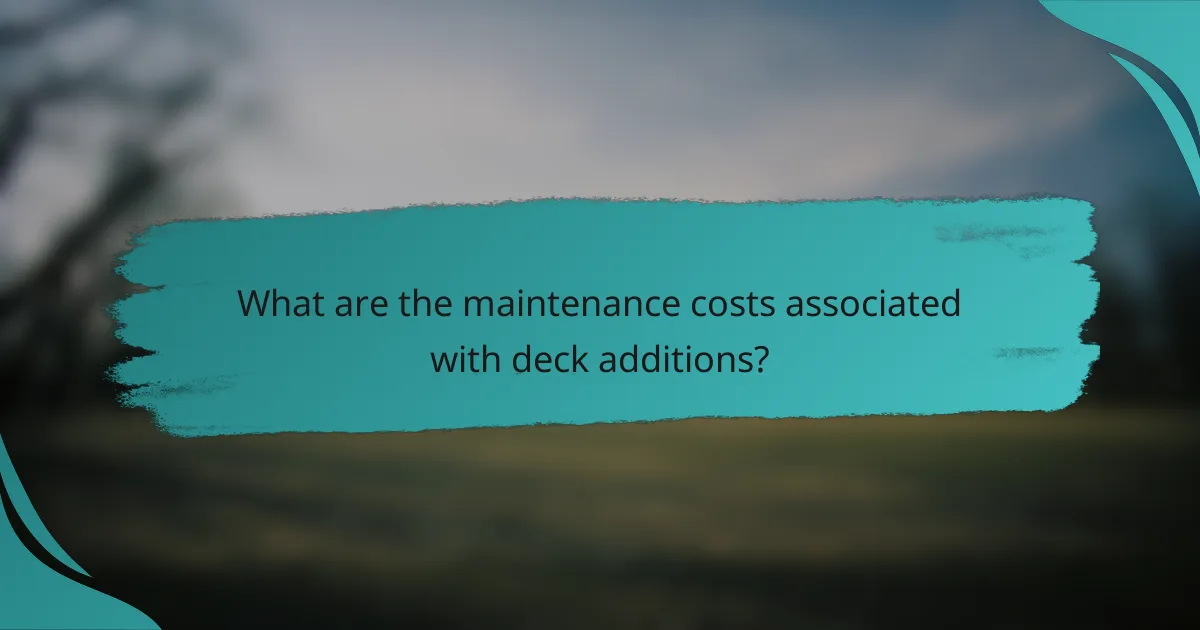Adding a deck to your home can significantly enhance its value and outdoor living space, but it’s essential to understand the associated costs and budgeting strategies. Cost estimates for a deck addition can vary widely based on materials, size, and complexity, so careful planning is crucial. Additionally, exploring financing options such as home equity loans or personal loans can help manage these expenses effectively.

What are the cost estimates for a deck addition in Canada?
The cost estimates for a deck addition in Canada typically range from several thousand to tens of thousands of Canadian dollars, depending on various factors such as materials, size, and complexity. Homeowners should budget accordingly and consider financing options to manage these expenses effectively.
Average cost range
The average cost for a deck addition in Canada generally falls between CAD 15,000 and CAD 30,000. Basic wooden decks may be on the lower end of this spectrum, while more elaborate designs with premium materials can push costs higher. It’s crucial to obtain multiple quotes to ensure a fair estimate.
Factors affecting costs
Labor costs vary by region and contractor experience, which can add to the overall expense. Permitting and zoning regulations may require additional fees, so it’s wise to check local requirements before starting your project.
Regional price variations
Additionally, seasonal factors can play a role; demand for deck construction often peaks in spring and summer, which may lead to increased prices during these months. Planning your project during the off-peak season could yield cost savings.

How to budget for a deck addition?
Budgeting for a deck addition involves estimating costs, planning for expenses, and securing financing. Understanding the total investment required will help you allocate resources effectively and avoid unexpected financial strain.
Creating a budget plan
Start by determining the overall cost of your deck addition, which can vary widely based on materials, size, and design. A basic wood deck might range from $15 to $30 per square foot, while composite materials can increase costs to $30 to $60 per square foot. Include additional expenses such as permits, labor, and landscaping.
Next, outline your budget plan by listing all potential expenses and categorizing them into fixed and variable costs. Fixed costs include materials and labor, while variable costs may involve landscaping or furniture. This clarity will help you track spending and adjust as needed.
Common budgeting mistakes
One common mistake is underestimating the total cost of the project. Homeowners often overlook expenses like permits, inspections, and unexpected repairs, which can add up quickly. Always include a contingency fund of about 10-20% of your total budget to cover these surprises.
Another frequent error is failing to prioritize needs versus wants. While it’s tempting to include high-end features, focus on essential elements first. Consider what aspects of the deck are necessary for functionality before adding luxury items like built-in lighting or custom railings.

What financing options are available for deck additions?
Several financing options are available for deck additions, including home equity loans, personal loans, and credit cards. Each option has its own benefits and considerations, making it essential to evaluate which best fits your financial situation and project needs.
Home equity loans
Home equity loans allow you to borrow against the equity in your home, often at lower interest rates compared to other financing methods. Typically, lenders will allow you to borrow up to 80% of your home’s equity, which can provide substantial funds for a deck addition.
When considering a home equity loan, be aware of the closing costs and fees that may apply. It’s also crucial to ensure that you can comfortably manage the monthly payments, as your home serves as collateral.
Personal loans
Personal loans are unsecured loans that can be used for various purposes, including home improvements like deck additions. These loans usually have fixed interest rates and terms ranging from a few years to several years, making them predictable in terms of repayment.
While personal loans can be easier to obtain than home equity loans, they often come with higher interest rates. It’s advisable to compare offers from different lenders to find the best rates and terms that suit your budget.
Credit cards
Using credit cards for financing a deck addition can be convenient, especially if you have a card with a low interest rate or a promotional 0% APR offer. This option allows for flexible payments, but it can lead to high-interest debt if not managed carefully.
Consider using credit cards for smaller expenses related to the deck addition, or if you can pay off the balance quickly. Avoid maxing out your credit limit, as this can negatively impact your credit score and financial health.

What are the key considerations before starting a deck addition?
Before starting a deck addition, it is essential to consider permits, design options, and material choices. These factors significantly influence the overall cost, compliance with local regulations, and the longevity of your deck.
Permits and regulations
Obtaining the necessary permits is a critical step in the deck addition process. Most municipalities require a building permit to ensure that your project complies with local zoning laws and safety standards. Failing to secure these permits can result in fines or the need to dismantle your deck.
Check with your local building department to understand specific regulations, which can vary widely. Some areas may have restrictions on deck height, size, or proximity to property lines, so it’s vital to familiarize yourself with these rules before proceeding.
Design and material choices
Choosing the right design and materials for your deck can impact both aesthetics and budget. Common materials include pressure-treated wood, composite, and PVC, each with varying costs and maintenance needs. For instance, while pressure-treated wood is often more affordable upfront, it may require more maintenance over time compared to composite options.
Consider your lifestyle and how you plan to use the deck. If you entertain frequently, a larger deck with durable materials may be beneficial. Additionally, incorporating features like built-in seating or lighting can enhance functionality but will increase costs. Aim to balance your design aspirations with practical budgeting to avoid overspending.

How can I find a contractor for my deck addition?
Finding a contractor for your deck addition involves researching local professionals, checking their credentials, and gathering estimates. Start by seeking recommendations and ensuring the contractor has experience with similar projects.
Local contractor recommendations
To find reliable local contractors, ask friends, family, or neighbors for referrals. Online platforms like Yelp or Angie’s List can also provide reviews and ratings of contractors in your area. Additionally, check local home improvement stores for bulletin boards or recommendations from staff who work with contractors regularly.
Consider contacting local trade associations or builders’ groups, as they often have directories of licensed contractors. Ensure any contractor you consider is licensed and insured to protect yourself from potential liabilities.
Questions to ask potential contractors
When interviewing potential contractors, ask about their experience with deck additions, including how many similar projects they have completed. Inquire about their timeline for your project and their availability, as well as how they handle unexpected delays or changes.
It’s also essential to discuss payment terms and obtain a detailed estimate that outlines materials and labor costs. Ask for references from previous clients and follow up to gauge their satisfaction with the contractor’s work. Finally, ensure you understand the warranty offered on both materials and workmanship.

What are the maintenance costs associated with deck additions?
Maintenance costs for deck additions can vary significantly based on materials, climate, and usage. Regular upkeep is essential to prolong the life of the deck and can include cleaning, sealing, and repairs.
Annual maintenance expenses
Annual maintenance expenses for a deck typically range from a few hundred to over a thousand dollars, depending on the size and materials used. Common costs include cleaning solutions, sealants, and occasional repairs for wear and tear.
For example, wood decks may require annual sealing, costing around $200 to $400, while composite decks might need less frequent maintenance, potentially lowering costs to $100 to $300 annually.
Long-term upkeep considerations
Long-term upkeep of deck additions involves planning for periodic repairs and replacements. Factors such as weather exposure, foot traffic, and the quality of materials can influence the frequency and cost of maintenance.
Homeowners should budget for major repairs every 5 to 10 years, which can range from $500 to several thousand dollars, depending on the extent of damage and the materials involved. Regular inspections can help identify issues early, preventing more costly repairs down the line.

What are the latest trends in deck additions?
Deck additions are increasingly popular for enhancing outdoor living spaces, with trends focusing on sustainability, multifunctional designs, and the integration of technology. Homeowners are opting for eco-friendly materials and features that allow for year-round use, reflecting a shift towards more versatile and environmentally conscious outdoor areas.
Cost estimates for deck additions
The cost of deck additions can vary widely based on materials, size, and design complexity. On average, homeowners can expect to spend anywhere from $15 to $50 per square foot, depending on whether they choose wood, composite, or other materials. For a standard 300-square-foot deck, this could translate to a total cost ranging from $4,500 to $15,000.
When budgeting, consider additional expenses such as permits, labor, and any necessary site preparation. It’s wise to set aside an extra 10-20% of your budget for unexpected costs that may arise during construction.
Budgeting strategies for deck additions
Effective budgeting for a deck addition starts with defining your priorities and setting a realistic budget based on your financial situation. Break down the overall cost into categories such as materials, labor, and design features to better understand where your money will go.
Consider financing options if your budget is tight. Many homeowners find that saving for a few months or even a year can make a significant difference in their ability to afford higher-quality materials or features. Additionally, keep an eye out for seasonal sales or promotions from local suppliers.
Financing options for deck additions
Financing a deck addition can be accomplished through various means, including personal loans, home equity lines of credit (HELOC), or credit cards. Personal loans typically offer fixed interest rates and predictable monthly payments, making them a popular choice for many homeowners.
Home equity loans or HELOCs allow you to borrow against the equity in your home, often at lower interest rates than personal loans. However, this option requires careful consideration of your overall financial health and the potential risks involved in leveraging your home. Always compare interest rates and terms before committing to any financing option.
